Looking to add color and beauty to your gardens? Here’s a step-by-step guide for planting hydrangeas in the ground and in pots, urns, or planters. From where to plant hydrangeas to how to take care of them, this post will help you create a beautiful summer display for years to come.
If you are looking for a way to add a big splash of color and charm to your gardens or around your patio and porch, then the obvious choice is hydrangeas. These hearty ornamental shrubs, with their large showy flower clusters, will amp up the beauty and interest in your outdoor spaces. Here is the ultimate guide for planting hydrangeas in the ground, in pots, and in urns.
Hydrangeas are easy to plant and grow. With just a little care and occasional attention, these old-fashioned beauties will gift you with a long season of vibrant mophead blooms.
This post gives you an easy step-by-step guide for adding the color and beauty of hydrangeas to your outdoor spaces.
Hydrangeas (genus hydrangea) are woody shrubs native to the Western Hemisphere and Asia. These Grandiflora shrubs grow in zones 3-7 as perennials. There are over 75 hydrangea varieties, with new varieties popping up every year.
Typically, hydrangeas bloom in the spring and summer, and some varieties can last through the fall. The flowerheads start as buds from sturdy stems. Depending on the type of hydrangea, some blooms grow on old wood and some on new. Knowing this will determine when to prune hydrangeas back.
The Perfect Potting Soil for Vibrant Hydrangeas
Hydrangeas are one of the most popular flowering shrubs grown in gardens and containers. Their large showy blooms add incredible beauty and provide months of colorful enjoyment. However, in order to get the most out of your hydrangeas using the right potting soil is crucial. This comprehensive guide will teach you everything you need to know about choosing the perfect potting mix for vibrant, thriving hydrangeas.
Why Potting Soil Matters for Hydrangeas
Unlike when planted in the ground, container-grown hydrangeas rely completely on their potting soil to provide nutrients, drainage, and an environment where their roots can spread out. Using a low-quality potting mix can severely limit their growth and flowering capabilities.
On the other hand, the right soil gives hydrangeas what they need to become established, grow vigorously, and produce their signature bold blooms. When selecting a potting soil, it’s important to take hydrangeas’ specific needs into account.
Key Characteristics of Quality Hydrangea Potting Mixes
Here are the most important features to look for in a high-quality potting soil for hydrangeas:
-
Excellent drainage: Hydrangeas are prone to root rot if their soil stays wet for too long. A potting mix with materials like perlite, vermiculite, or bark mixed in improves drainage to prevent soggy soil.
-
Moderate moisture retention: While drainage is crucial, the soil should also retain some moisture between waterings. Ingredients like coconut coir help keep soil from drying out too rapidly.
-
Acidic pH: Most hydrangeas prefer slightly acidic soil with a pH of 5.5-6.0. When grown in containers, the pH often needs to be lowered by incorporating aluminum sulfate.
-
Nutrient-rich: Potting mixes made for blooming plants contain fertilizer to feed heavy feeders like hydrangeas. Slow-release or organic fertilizers are ideal.
-
Lightweight and fluffy: Hydrangea roots need room to spread out and take hold. A loose, airy potting mix allows for better root establishment.
Recommended Potting Soil Options for Hydrangeas
With those key criteria in mind, here are some of the best potting soil options specifically formulated for vibrant hydrangeas:
- Miracle-Gro Moisture Control Potting Mix
This potting soil from Miracle-Gro checks all the boxes. It contains coconut coir and a special polymer to help prevent drought stress. Perlite provides drainage while the fertilizer feeds for up to 6 months. The lightweight mix is excellent for container gardening.
- Espoma Organic Potting Mix
For an organic choice, Espoma’s blend contains sphagnum peat moss, peat humus, perlite, and mycorrhizae fungi to enhance nutrient uptake. It works well for a variety of container plants, hydrangeas included.
- Sun Gro Black Gold All Purpose Potting Soil
A top seller, this Sun Gro mix offers a balanced blend of drainage, moisture retention, and fertilizer for hydrangeas. It’s a peat-based mix amended with controlled-release fertilizer and vermiculite.
- Miracle-Gro Nature’s Care Organic Potting Mix
Miracle-Gro also makes an organic blend ideal for hydrangeas. It contains compost, sphagnum peat moss, and coconut coir to help retain moisture. Organic fertilizers like bone meal gradually feed plants.
- Black Gold Hydrangea Potting Soil
Specifically made with hydrangeas in mind, this Black Gold soil is lightweight and contains moisture retention gels to prevent drought stress. The acidic pH is optimal for blooming hydrangeas.
Tips for Growing Hydrangeas in Containers
Once you select the right potting soil, follow these tips to keep your potted hydrangeas thriving season after season:
-
Fertilize every 2-4 weeks during the growing season with a fertilizer made for acid-loving plants.
-
Monitor the soil pH periodically and amend as needed to maintain the ideal slightly acidic levels.
-
Add 2-4 inches of mulch on top of the soil to help retain moisture and prevent weeds.
-
Water whenever the top inch of soil dries out, checking soil daily in hot weather.
-
Repot into fresh soil every 2-3 years as old mix loses structure and nutrients.
Follow this complete guide to ensure your container hydrangeas get the specialized potting mix they require. Paying close attention to soil selection and care leads to showstopping hydrangeas all summer!
Choosing the Ideal Hydrangea Varieties for Containers
While most hydrangeas can be grown in pots, some varieties are better suited for container culture than others. Here are some top picks:
-
Endless Summer: These reblooming bigleaf hydrangeas flower on both old and new wood, extending the bloom period.
-
Cityline Series: These panicle hydrangeas stay compact, blooming on new wood. Paris and Vienna are popular options.
-
Let’s Dance Series: Reblooming bigleaf types that stay compact and bloom all season on new wood.
-
Mini Penny: A dwarf panicle hydrangea that’s perfect for small space gardens.
-
Bobo: This panicle hydrangea stays under 3 feet, making it a great choice for containers.
-
Little Lime: As the name suggests, a dwarf, compact hydrangea that lights up containers.
Where to Position Container Hydrangeas
Hydrangeas thrive with morning sun and afternoon shade. East-facing locations are ideal in hot climates. Keep pots well-watered and move to a shadier spot if leaves show signs of scorching. Sheltered spots protected from strong wind are best.
Group container hydrangeas together for a bold, colorful display. Mix varieties with contrasting bloom colors like blues, whites and pinks for lots of visual interest.
Preparing the Right Soil for In-Ground Hydrangeas
While container gardening allows you to customize and control the potting mix, planting in the ground requires amending your existing soil. Here are tips for preparing in-ground soil for healthy, thriving hydrangeas:
-
Loosen soil and mix in compost, manure or peat moss to improve drainage in heavy clay soils.
-
For sandy soils, add extra organic matter like composted manure to increase moisture retention.
-
Test soil pH and amend as needed to reach the ideal slightly acidic range.
-
Work fertilizer tailored for acid-loving plants into beds before planting. Use an organic or slow-release product.
-
Add 2-4 inches of shredded bark, compost or pine needles as mulch to help retain moisture and reduce weeds.
-
Monitor soil moisture weekly and water whenever the top few inches become dry. Increase watering during hot, dry periods.
With the proper soil preparation, in-ground hydrangeas will flourish, producing their signature bold blooms year after year. Paying attention to their specialized needs goes a long way toward success.
Picking the Best Hydrangeas to Grow In-Ground
While most hydrangeas tolerate partial shade, the following varieties thrive with less light, making them excellent choices for in-ground planting:
-
Bigleaf hydrangeas like Endless Summer bloom on old and new wood, extending the season.
-
Lacecap hydrangeas like Blue Wave feature delicate, eye-catching blooms.
-
Oakleaf hydrangeas like Alice offer gorgeous fall foliage and flowers.
-
Climbing hydrangeas like Cityline Paris cover walls and arbors with blooms.
-
Annabelle hydrangeas produce huge, white panicle blossoms.
-
H. paniculata varieties like Quick Fire and Little Lime offer earlier blooms.
-
Mountain hydrangeas like Evergreen provide hardiness and lacecap blooms.
With proper siting, soil preparation, and care, these hydrangeas will flourish planted in beds and borders. Choose varieties suited to your growing zone.
Essential Care Tips for Potted and In-Ground Hydrangeas
Follow these essential care guidelines to keep hydrangeas looking their best:
-
Water thoroughly and regularly, never allowing soil to completely dry out.
-
Apply slow-release or organic fertilizer formulated for hydrangeas every 4-6 weeks during the growing season.
-
Prune immediately after flowering, cutting back to just above a set of healthy buds.
-
Check soil pH yearly, amending as needed to maintain the ideal slightly acidic levels.
-
Protect potted hydrangeas from frost and freezing temperatures by moving to a protected area.
-
Remove faded flowers regularly to encourage more blooms. Don’t prune deeply into old wood.
-
Mulch around plants to regulate soil temperature and moisture. Replenish mulch yearly.
-
Repot container plants every 2-3 years using fresh potting mix to provide nutrients.
By understanding their preferences for rich, moist, well-drained acidic soil, proper siting, and attentive care, your hydrangeas will reward you with their famously lush foliage and bountiful colorful blooms. Follow this guide and you’ll be on your way to vibrant in-ground and container-grown hydrangeas.

Planting Hydrangeas In The Ground
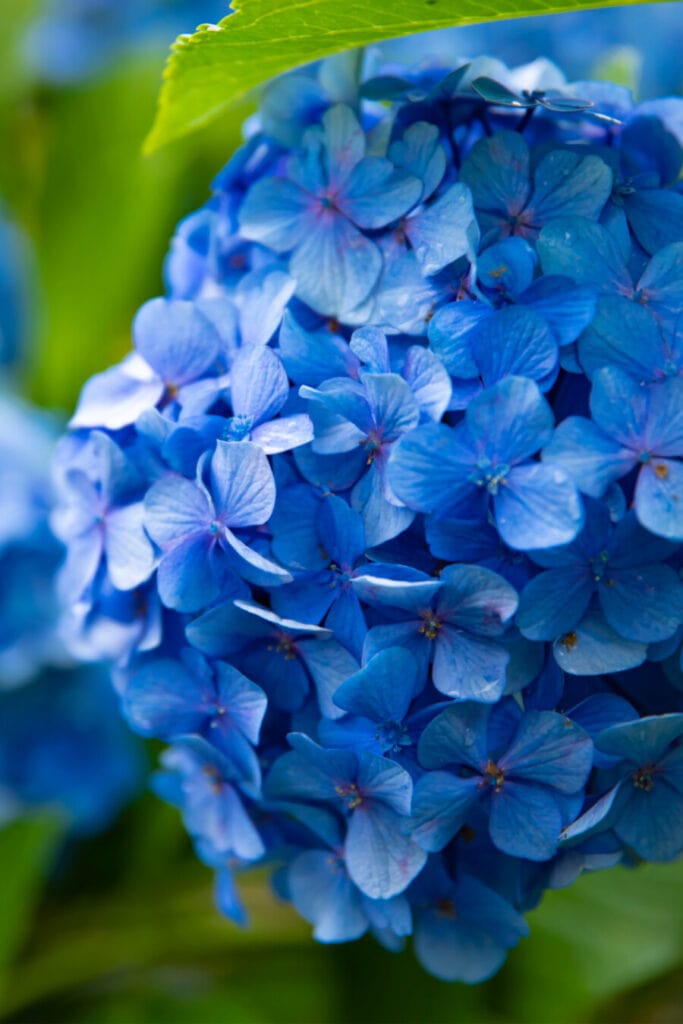
We recently planted three Let’s Dance Rhythmic Blue Bloomsturck hydrangeas in our front yard, near our walk. These reblooming bigleaf shrubs grow 2-3 feet high and spread out to cover a 3-foot area.
Bobby did the work, and I took the pictures. Here’s how we planted them…
Planting hydrangeas could not be easier. If you are planting hydrangeas in an established garden bed, push away any mulch.
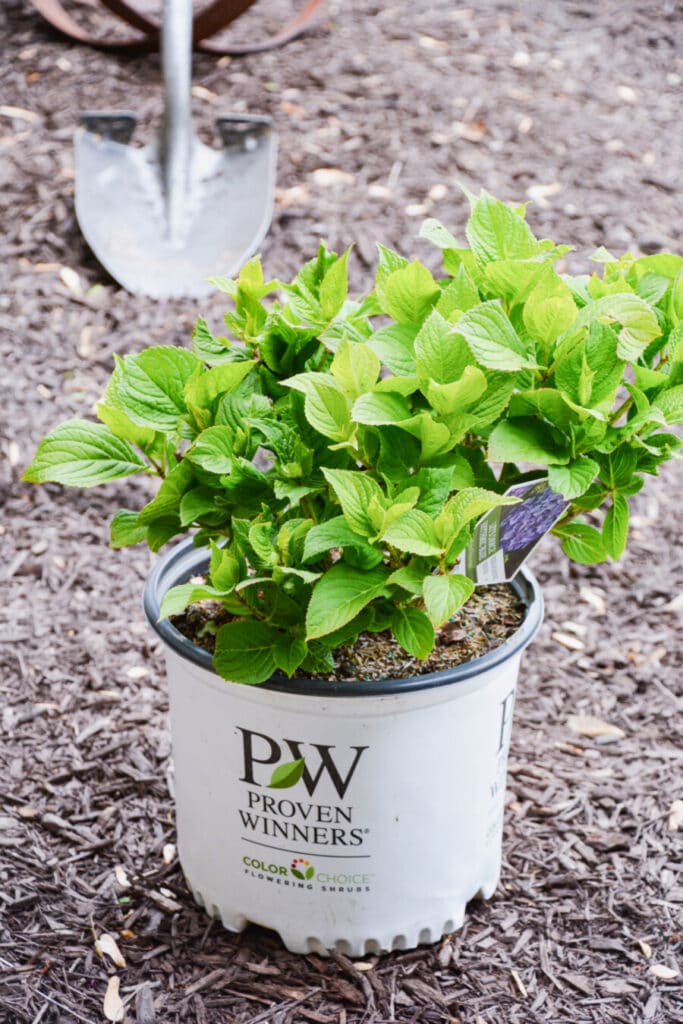
Dig a hole two times as wide as the hydrangea’s root ball. The depth of the hole should meet the base of the plant.
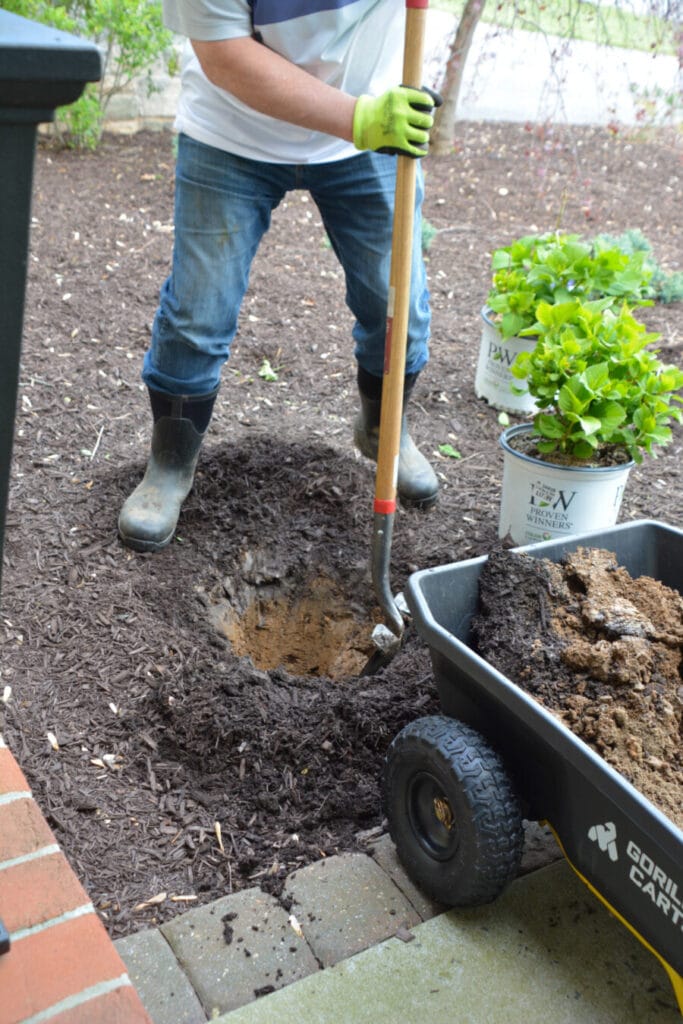
Set the dirt aside on a piece of plastic or another container. We removed the dirt to a small wheelbarrow.
We amended the dirt by mixing in professional-grade compost with fertilizer. Doing this gives the shrub the nutrients it needs to become established and grow.
Inspect the root ball for any dead or rotten roots and snip them off. Gently rub the root ball to loosen the roots so that when they are planted, they will reach out into the soil and establish the shrub. This step is essential for a healthy root system.
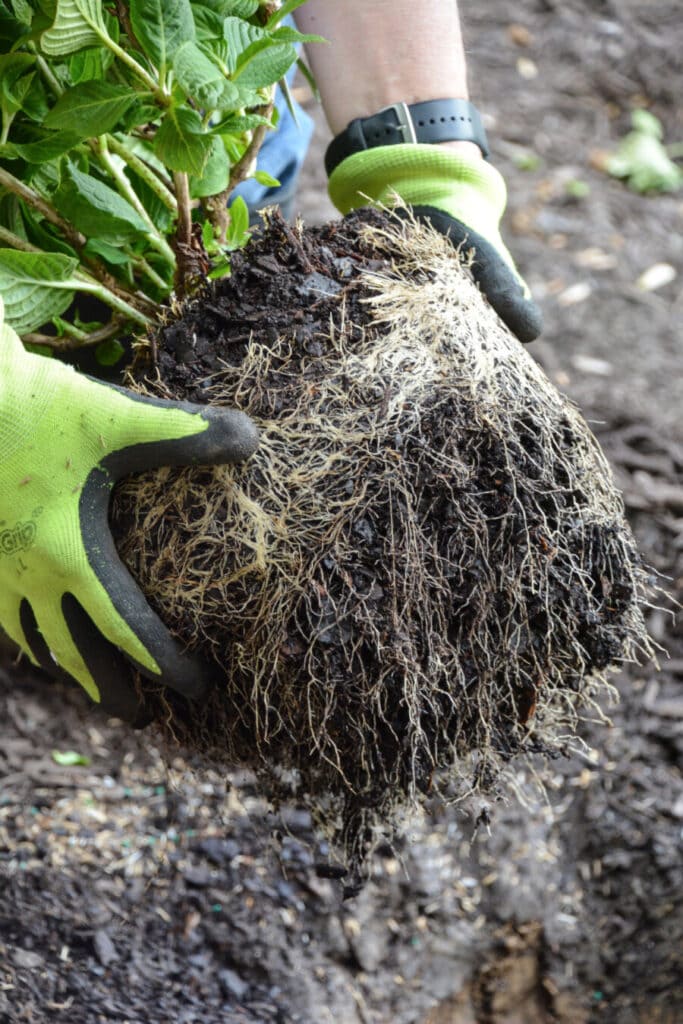
Set the hydrangea in the hole and backfill with the amended soil, and replace the mulch around the plant.
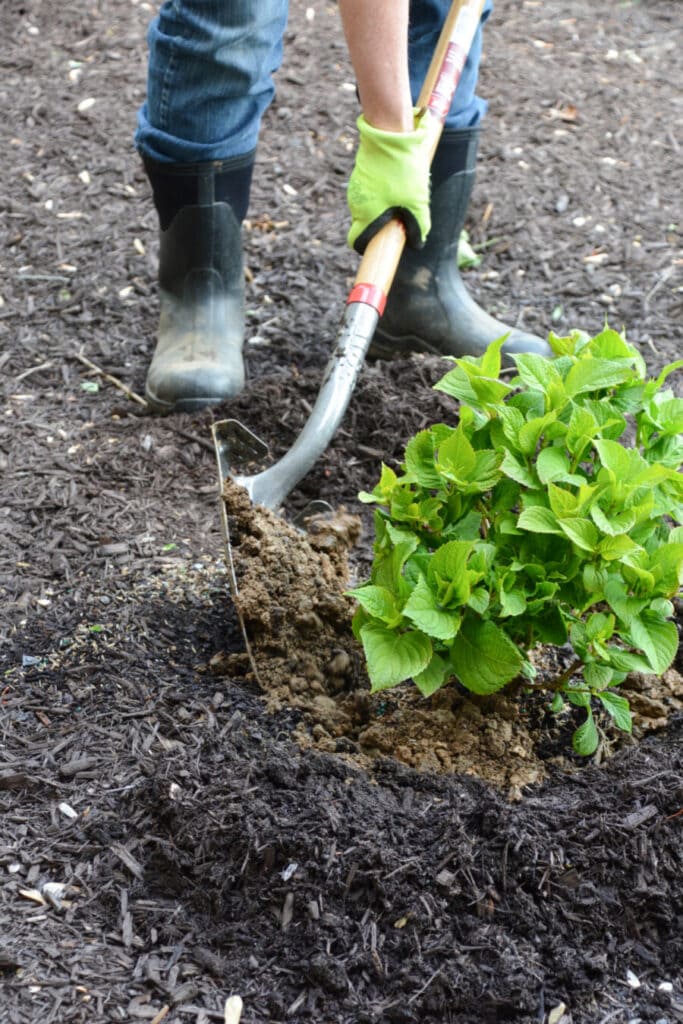
Water the shrub well. Water the plant every couple of days for the first few weeks.
The pH of the soil in most gardens is rather neutral, and hydrangeas grow well in this soil. Ph is important when it comes to changing the color of the bigleaf and mountain hydrangeas flowers.
Acidic soil (pH 5.5 or lower) will produce blue blooms, while alkaline soil (pH 60-6.2) will produce pink flowers.
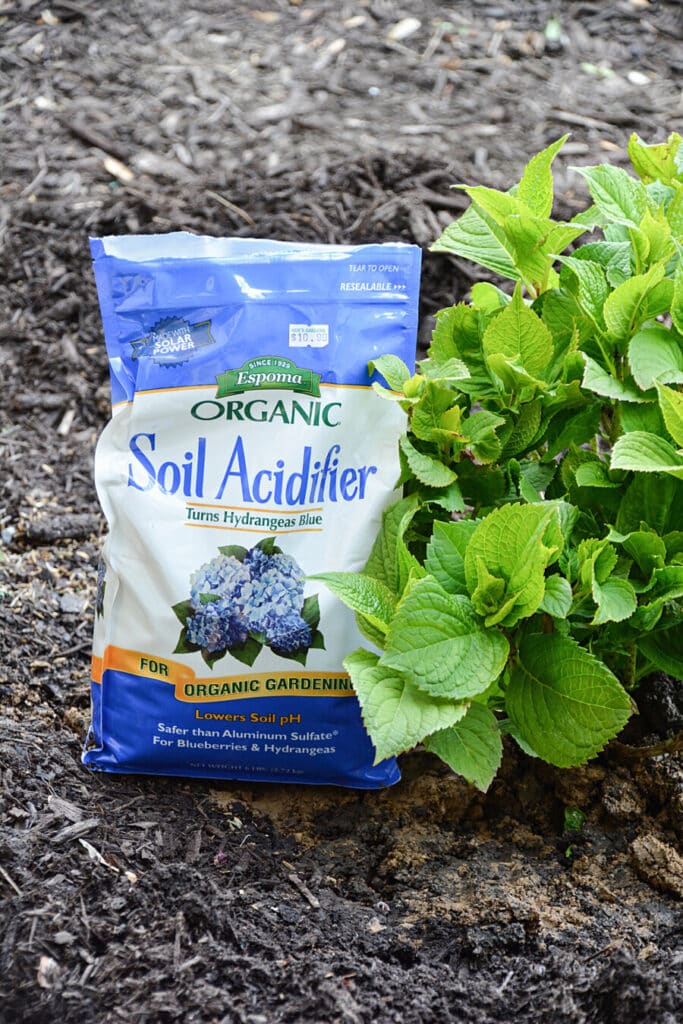
We used a commercial mix of aluminum to amend the soil pH and make it more acidic since we wanted blue blooms. Following the directions, we added 1/2 cup of the compound around the shrub’s dripline.
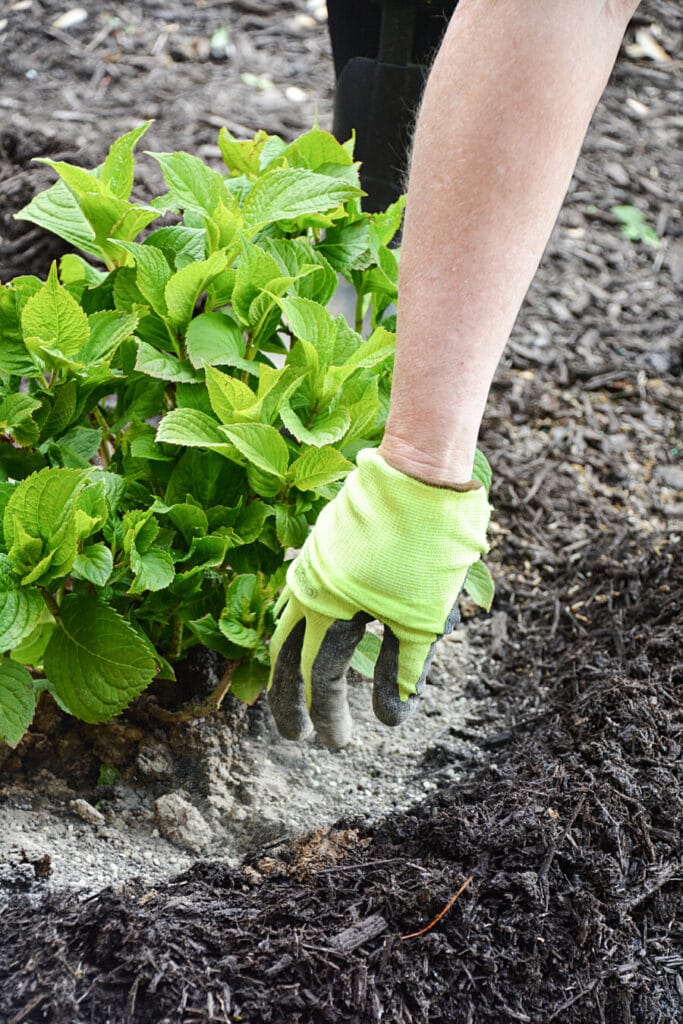
Lime can be applied to the dripline to produce pink blooms.
How To Plant Hydrangeas In Planters
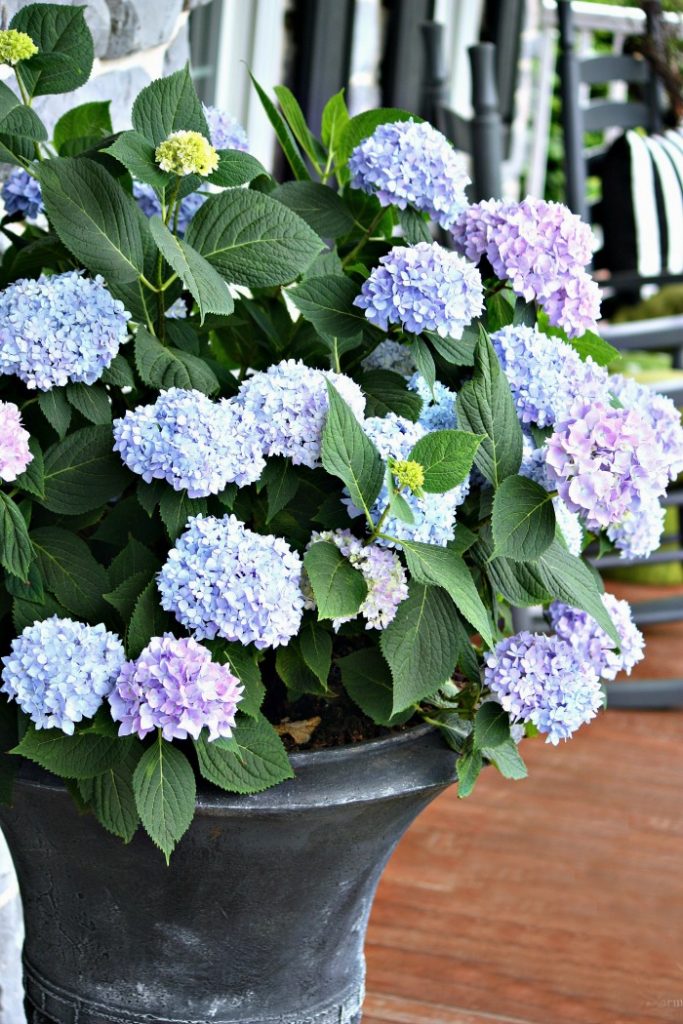
Planting hydrangeas in pots and ur is simple. Follow these tips, and you will be rewarded with a healthy plant and beautiful blooms.
Dig a hole in your soil a little larger than the pot the hydrangea comes in. If you do not use potting soil that has timed-release fertilizer, put some timed-release fertilizer in the bottom of the hole according to the directions on the fertilizer container. Be careful not to use too much, or you will burn the roots. Just a little bit will do, and mix it in with the soil! If you are using amended soil (see above), skip this step.
Loosen the root ball of the shrub, like discussed for planting hydrangeas in the ground.
Plant the hydrangea in the soil, making sure the crown (where the base of the plant meets the soil) is level with the top of the potting soil. If the crown sits too high, it will dry out faster, and if it is planted too deeply in the soil, the hydrangea might not bloom and rot.
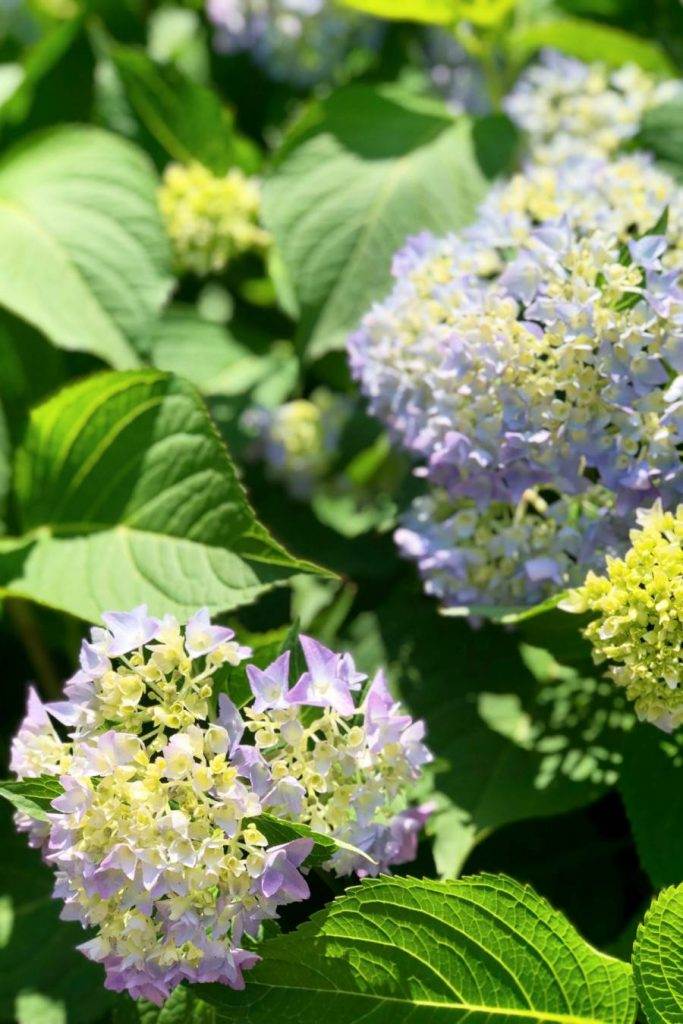
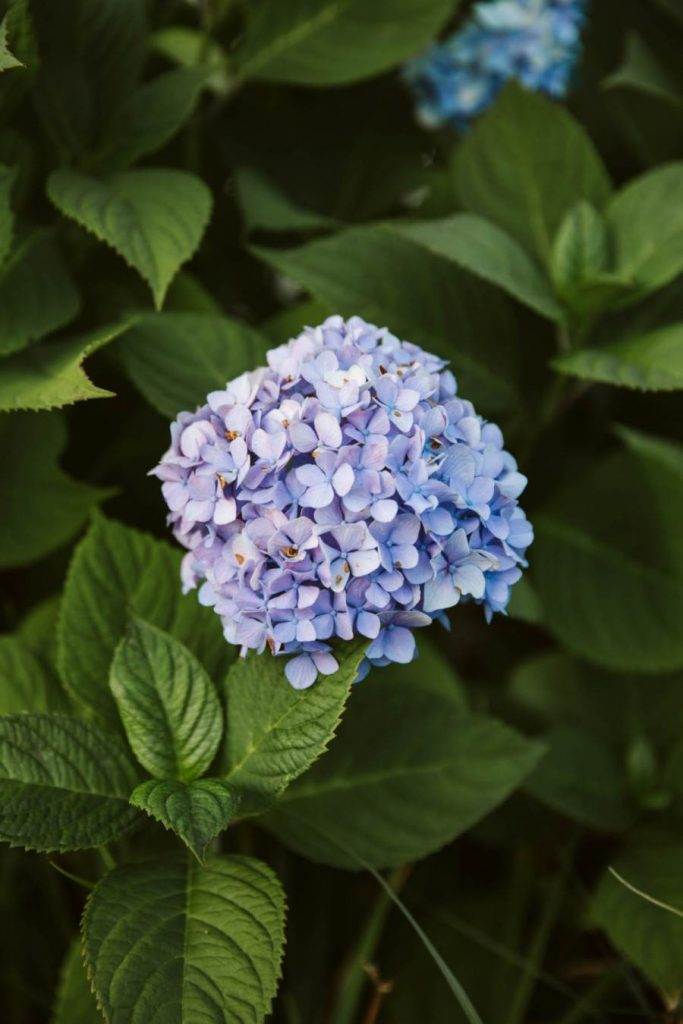
Hydrangeas love water! They like to be hydrated but not wet! If they are too wet, it stunts their blooms and rots their roots. They also like to be in a pot that drains well. Because they are in a pot and not in the ground, I suggest watering them daily when the weather gets hot. Give the soil in the pot a little poke with your finger. If it feels dry, it’s time to give them a good soak.
Hydrangeas may wilt a little in hot weather, but they will revive when temperatures drop in the evening and night. To help my hydrangeas stay hydrated, I water them in the morning so the soil is moist in the hot afternoons.
You can make an easy self-watering system that works wonderfully with hydrangeas and any planter that needs water. Just wait until you see how easy it is.
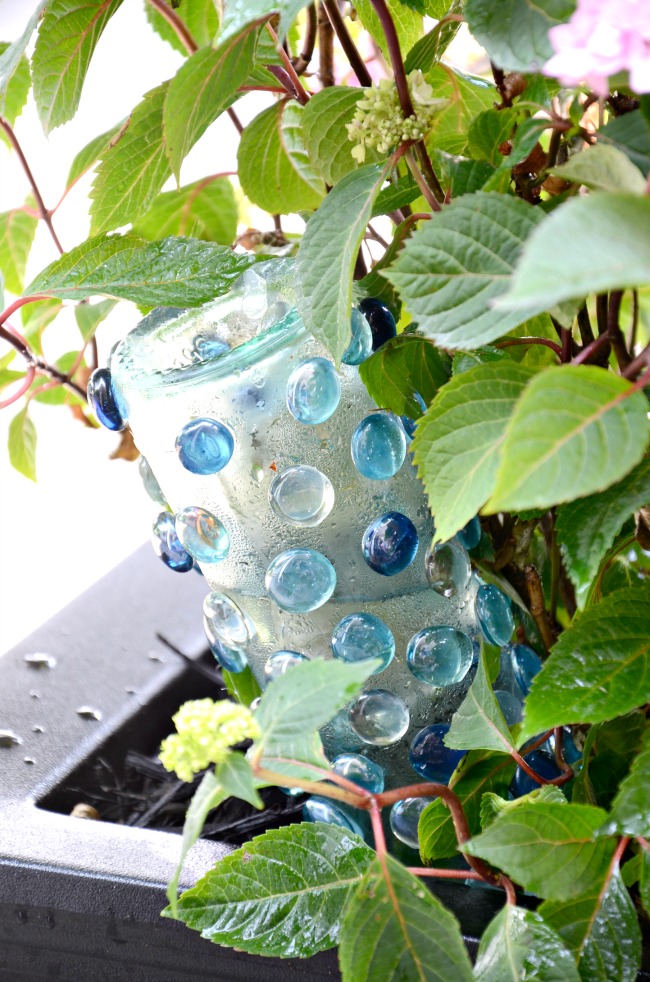
Growing Hydrangeas In Pots ~ Compact Hydrangeas Perfect For Containers
FAQ
Is Miracle-Gro potting soil good for hydrangeas?
What Kind of Soil to Use for Hydrangeas. To grow hydrangeas in planting beds, focus on improving the native soil. One simple way to do that is to combine equal parts existing soil and Miracle-Gro® Garden Soil for Trees and Shrubs.
What soil do hydrangeas grow best in?
You’re in luck if you have loam soil as your hydrangeas will naturally thrive in your space.
What potting soil is best for hydrangeas?
It contains compost, sphagnum peat moss, and coconut coir for moisture retention. There are also added organic fertilizers like bone meal and feather meal to gradually feed plants. As the name suggests, this Black Gold potting soil is specially formulated with the needs of hydrangeas in mind.
How do I choose a hydrangea potting mix?
Here are the most important characteristics to consider: Good drainage Hydrangeas need soil that drains well. Their roots are prone to rotting if left in standing water or sodden soil for too long. Look for potting mixes that contain materials like perlite vermiculite or bark to help improve drainage.
Can hydrangeas grow in containers?
Hydrangeas have specific soil requirements that must be met in order for the plants to thrive. When grown in the ground it’s a bit easier to amend and alter the existing soil to create the ideal growing medium for hydrangeas. However when grown in containers, the only soil the plant has access to is the potting mix you provide.
Can hydrangeas grow in poor soil?
Soil that is poor in nutrients is not ideal for planting Hydrangea. You need to create the ideal soil mix that would allow Hydrangea to thrive. You can do this by adding organic materials like Coco-fiber potting medium along with compost to improve the quality of the soil.
How to grow Hydrangeas in a pot?
If possible, it is also good to line the bottom of your pot with rock layers or even Hydroton to let the water to readily drain out without necessarily clogging the drain holes at the bottom. Good drainage is essential to the proper growth of hydrangeas. Hence, you must use soil that is mainly designed for planters.
Do hydrangeas need organic soil?
In the planting hole, incorporating organic materials and providing good drainage ensures a healthy root system, vital for various hydrangea species. With a careful blend of organic amendments like peat moss and garden lime, gardeners can achieve the desired soil structure for optimal water retention and nutrient absorption.
